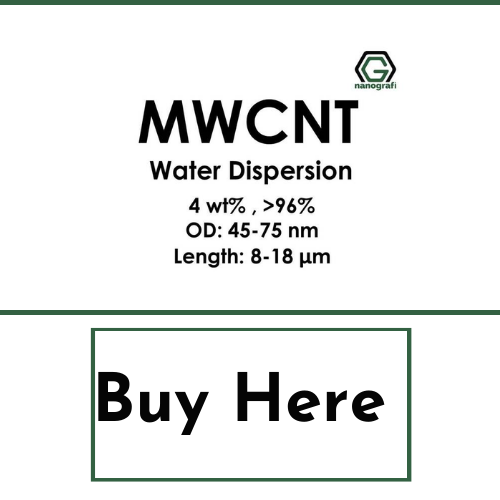Multi-walled Carbon Nanotubes
The discovery of carbon nanotubes (CNTs) in 1991 has stimulated intensive research to characterize their structure and to determine their physical properties both by direct measurement and through predictive methods using modeling techniques.
Many of their fundamental and remarkable properties are now well-known, and their exploitation in a wide range of applications forms a large part of the research effort now in progress.
Introduction
The electronic properties of carbon nanotubes (CNTs) have already had a significant impact on field emission applications in various electronic devices, while their geometry offers a new and exciting means of precision-controlled drug delivery. However, it is their extraordinary mechanical properties (exceptionally high tensile strength and stiffness) that has aroused interest and promoted research into the fabrication of nanotube composite materials. The credit for discovering multi-walled carbon nanotubes is given to Sumio Iijima, who in 1991 reported on carbon microtubulii found as by-products in the Krätschmer electronic arc discharge reactor used for fullerene synthesis. Multi-walled carbon nanotubes can be distinguished clearly from single-walled and double-walled carbon nanotubes based on their larger diameter and their Raman spectrum. The distinction between MWCNTs and carbon nanofibers relies on the well-defined structure of carbon nanotubes: any elongated carbonaceous object with diameter below ∼500 nm that does not feature a carbon nanotube structure is a carbon nanofiber (CNF). Multi-walled carbon nanotubes (MWCNTs) are elongated hollow cylindrical nanoobjects made of sp2 carbon. Their diameter is 3–30 nm and they can grow several cm long, thus their aspect ratio can vary between ten and ten million. The wall thickness of a MWCNT is fairly constant along the axis, and therefore the inner channel is straight. This channel is not directly accessible from the outside because the ends of perfect MWCNTs are capped by half fullerene spheres; however, it can be accessed by opening the nanotube using, e.g., oxidation, milling or ion beam treatment.
Physical Properties of Multi-Walled Carbon Nanotubes
As-synthesized multi-walled carbon nanotubes appear as fluffy black powder with a very low apparent density between 0.03 g/cm3 and 0.22 g/cm3. The skeletal density of MWCNTs was measured to be 1.74 g/cm3 in 2009. Today, skeletal densities of 2.1 g/cm3 are usually reported. MWCNTs are agglomerated after synthesis and can be separated by physical methods. Purification and functionalization in solution result in an agglomerated, dense material which is difficult to disperse again even by using high-energy ultrasonic horns. The solubility of MWCNTs is very low in all liquids, and the stacking of MWCNTs are caused by the high (500 eV/µm) tube–tube van der Waals interaction energy makes creating stable solutions a very challenging task. Actually, the term solution should not be used for MWCNTs at all. Rather, multiwalled carbon nanotubes form colloidal solid/liquid (S/L) dispersions in solvents, and therefore MWCNT solutions should be referred to as sols.
Mechanical Properties
In principle, the mechanical properties of MWCNTs in the axial direction are exceptional, with Young’s modulus in the TPa range and tensile strength of 60 GPa. MWCNTs are softer in the radial direction, as indicated by a radial Young’s modulus of 30 GPa and up to 40% radial deformability.
Electrical Properties
The electronic properties of individual MWCNTs have not yet been studied as extensively as those of single-walled nanotubes. The longitudinal polarizability of MWCNTs is given by the sum of the polarizabilities of the constituent tubes. The transverse response is dominated by the outer layers. The electric current conductivity of arc-discharge-synthesized MWCNTs is 104 S/m and that of annealed CVD MWCNTs is 2 × 105 S/cm, which renders them useful for lightweight wire and cable applications (compare with 59.6 × 106 S/m for pure copper). Electrical conductivity in the longitudinal direction is an order of magnitude higher than in the transverse direction.
Thermal Properties
The thermal conductivity of aligned MWCNT films was found to be 15–25 W/(m.K) when measured with the 3ω technique. By taking the volume filling fraction into account, this number translates to an effective average thermal conductivity of 200 W/(m.K) for MWCNTs. Measurements performed on individual multi-walled carbon nanotubes yielded thermal conductivities around 650–830 W/(m.K) for supported and over 3000 W/(m.K) for free-standing suspended MWCNTs at room temperature, respectively.
Synthesis
Multi-walled and single-walled carbon nanotubes can be prepared using the same general techniques tuned towards one or the other tube type. A broad variety of synthesis methods have been developed in the past 20 years, and now MWCNT synthesis is a well-established process that has successfully been scaled up to a commercial level. Catalytic chemical vapor deposition (CCVD) is the most feasible and widespread synthesis method today; however, arc discharge and laser ablation must also be mentioned.
Arc Discharge
Arc discharge carbon nanotube synthesis reactors operate by igniting an electric arc (60–100 A across a potential drop of 25 V) between two graphite electrodes in a gaseous atmosphere (typically an argon/hydrogen mixture). The temperature in an electric discharge may reach as high as 4000℃, and a plasma is formed. The electrode material evaporates and condenses as filamentous carbon product on the cathode which contains carbon nanotubes. Using this method, successful fullerene (1990) and carbon nanotube synthesis (1991) were performed. Advantages of the arc discharge method are its simplicity and versatility in terms of carbon source material and catalyst. Its major disadvantages are the high energy consumption, low potential for industrial up-scaling, and the necessity for postproduction purification steps. The product formed on the cathode is composed of various types of carbonaceous matter, including nanotubes, fullerenes, carbonaceous nanoparticles, and catalyst.
To find out more, you can read Applications of Carbon nanotubes in water purification.
Laser Ablation
Laser ablation is the method that started the nanocarbon revolution back in the 1980s. When a laser beam is used for evaporating a carbon target, generally containing transition metals as catalyst component, similar processes take place as in arc discharge. In a typical laser ablation experiment, the second harmonic of a Nd:YAG laser pulse is focused onto a graphite target containing 1–2 at.% catalyst metal. The target is kept in an inert gas flow, and the system is heated to 800–1400 ◦C by an electric furnace. The laser evaporates the target into a plasma in which carbon nanotubes are formed. The produced nanotubes are swept by the inert gas stream onto a cold finger collector and removed periodically from the reactor. Laser ablation is unsuitable for mass production. On the other hand, it yields very high-quality nanotubes, and therefore it has been the synthetic method of choice for many fundamental studies.
CCVD Methods
CCVD stands for catalytic chemical vapor deposition. Although CVD is also a valid term in general, CCVD should be preferred when discussing carbon nanotube synthesis because all CVD-based CNT production methods rely on a catalyst. In a general CCVD synthesis, a volatile carbon source (hydrocarbons, alcohols, CO, etc.) is introduced into a reactor, where it is decomposed on a suitable catalyst (transition metal) surface and its carbon content is recrystallized in carbon nanotube form. Both single-walled and multi-walled carbon nanotubes can be produced by CCVD. Advantages of the CCVD method include cost efficiency, scalability, continuous operation, and relatively low (500–800℃) operating temperature. Combined with the ability to yield aligned nanotubes that grow in predesigned patterns only, this latter property renders CCVD a good candidate for integration with the silicon-based semiconductor industry. Notable disadvantages of the CCVD method are the lower quality (more defects in the wall structure and more carbonaceous contamination deposit) of the synthesized nanotubes and the necessity for a post-synthetic purification step in which the catalyst and/or catalyst support are removed.
Applications of MWCNTs
There are many applications for MWCNTs from waterproof and tear resistant cloth fabrics, concrete and steel like applications based on the property of strength, electrical circuits based on electrical conductivity, sensors based on their thermal conductivity, vacuum proof food packaging, and even as a vessel for delivering drugs.
Electronic Packaging
Electronic packaging is to protect and cool the microelectronic chips as well as to provide electrical and mechanical connections between the chip and the outside world. Among the different types of filler used in composite materials, the only one having exceptionally high thermal conductivity and unique mechanical properties is the multi-walled carbon nanotube. Thus, MWCNTs are generally used as electronic packaging materials.
Conductive Polymers
Over the last century, scientists have been focusing on a potent material that would replace metal in various sectors, though plastic has made its way but it still remains devoid of electrical conductivity, as a result of which metal is often preferred over it. But, Multiwalled carbon nanotubes can be a superior replacement that would not only overcome the deficiency of metals but at the same time offer better conductivity.
In addition, potential applications of carbon nanotubes can be listed as; additives in polymers, catalysts, electron field emitters for cathode ray lighting elements, flat panel display, gas-discharge tubes in telecom networks, electromagnetic-wave absorption and shielding, energy conversion, lithium-battery anodes, hydrogen storage, nanotube composites (by filling or coating), nanoprobes for STM, AFM, and EFM tips, nanolithography, nanoelectrodes, drug delivery, sensors, reinforcements in composites and supercapacitors.
Biosensors
MWCNTs are very well suited to serve as a basis for biosensors, because they are electrically conductive, can be functionalized, and can act as an immobilization matrix formed into diverse macroscopic shapes of controlled porosity.
Conclusion
Realization of the extraordinary properties presented by carbon nanotubes holds much promise to revolutionize several fields, and scientists are tantalizingly close to achieving these remarkable changes.
To discover the latest articles in multi-walled carbon nanotubes, you can visit Blografi.
References
1.Tan, C. M., Baudot, C., Han, Y., & Jing, H. (2012). Applications of multi-walled carbon nanotube in electronic packaging. Nanoscale Research Letters, 7(1). doi:10.1186/1556-276x-7-183
2.Savi, P., Giorcelli, M., & Quaranta, S. (2019). Multi-Walled Carbon Nanotubes Composites for Microwave Absorbing Applications. Applied Sciences, 9(5), 851. doi:10.3390/app9050851
3.Coleman, J.N.; Khan, U.; Blau, W.J.; Gun’ko, Y.K. Small but strong: A review of the mechanical properties of carbon nanotube–polymer composites. Carbon 2006, 44, 1624–1652
4.Saib, A.; Bednarz, L.; Daussin, R.; Bailly, C.; Lou, X.; Thomassin, J.M.; Pagnoulle, C.; Detrembleur, C.; Jerome, R.; Huynen, I. Carbon nanotube composites for broadband microwave absorbing materials. IEEE Trans. Microw. Theory Tech. 2010, 1, 2745–2754
5.Miscuglio, M.; Yahya, M.H.; Savi, P.; Giorcelli, M.; Tagliaferro, A. RF Characterization of polymer multi-walled carbon nanotube composites. In Proceedings of the IEEE Conference on Antenna measurements & Applications (CAMA), Antibes Juan-les-Pins, France, 16–19 November 2014; pp. 1–4.
6.Yumura, M. (1999). Synthesis and Purification of Multi-Walled and Single-Walled Carbon Nanotubes. The Science and Technology of Carbon Nanotubes, 2-13. doi:10.1016/b978-008042696-9/50002-1
7.Hanada, T., Okada, Y., & Yase, K. (1999). Structure of Multi-Walled and Single-Walled Carbon Nanotubes. EELS Study. The Science and Technology of Carbon Nanotubes, 29-39. doi:10.1016/b978-008042696-9/50004-5
Recent Posts
-
Nanocomposites in Food Packaging
The utilization of nanocomposites in food packaging represents a significant advancement in the fiel …19th Apr 2024 -
What is the Difference Between 7075 and 6061 Aluminum Alloy?
When comparing 7075 aluminum alloy to 6061 aluminum alloy, it's essential to understand their disti …5th Apr 2024 -
Iron-Air Batteries: The Ultimate Guide
Iron-air batteries represent a significant breakthrough in energy storage technology, offering a sus …29th Mar 2024







